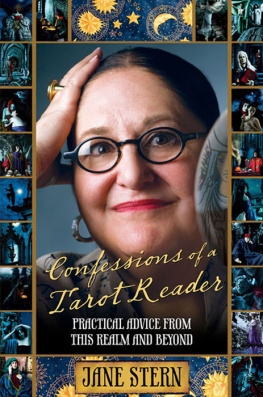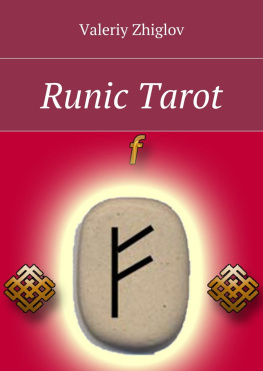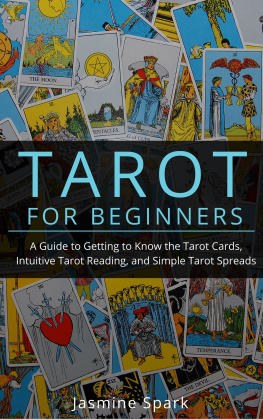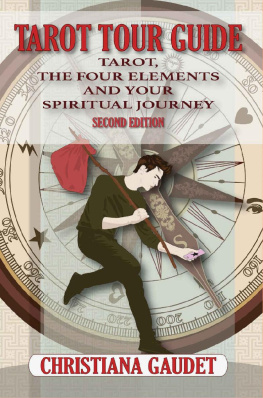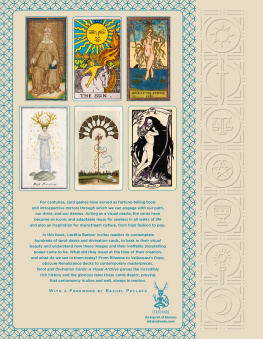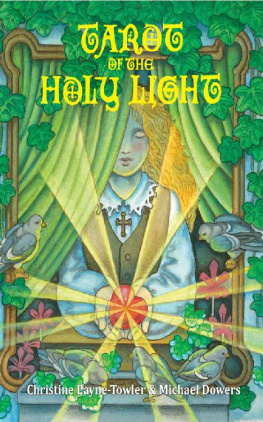Ronald Decker - The Esoteric Tarot
Here you can read online Ronald Decker - The Esoteric Tarot full text of the book (entire story) in english for free. Download pdf and epub, get meaning, cover and reviews about this ebook. year: 2013, publisher: Quest Books, genre: Science fiction / Religion. Description of the work, (preface) as well as reviews are available. Best literature library LitArk.com created for fans of good reading and offers a wide selection of genres:
Romance novel
Science fiction
Adventure
Detective
Science
History
Home and family
Prose
Art
Politics
Computer
Non-fiction
Religion
Business
Children
Humor
Choose a favorite category and find really read worthwhile books. Enjoy immersion in the world of imagination, feel the emotions of the characters or learn something new for yourself, make an fascinating discovery.
- Book:The Esoteric Tarot
- Author:
- Publisher:Quest Books
- Genre:
- Year:2013
- Rating:3 / 5
- Favourites:Add to favourites
- Your mark:
- 60
- 1
- 2
- 3
- 4
- 5
The Esoteric Tarot: summary, description and annotation
We offer to read an annotation, description, summary or preface (depends on what the author of the book "The Esoteric Tarot" wrote himself). If you haven't found the necessary information about the book — write in the comments, we will try to find it.
The Esoteric Tarot — read online for free the complete book (whole text) full work
Below is the text of the book, divided by pages. System saving the place of the last page read, allows you to conveniently read the book "The Esoteric Tarot" online for free, without having to search again every time where you left off. Put a bookmark, and you can go to the page where you finished reading at any time.
Font size:
Interval:
Bookmark:

The Esoteric Tarot
The Esoteric Tarot
Ancient Sources Rediscovered
in Hermeticism and Cabala
Ronald Decker

Theosophical Publishing House
Wheaton, Illinois * Chennai, India
Find more books like this at www.questbooks.net
Copyright 2013 by Ronald Decker
First Quest Edition 2013
Without limiting the rights under copyright reserved above, no part of this publication may be reproduced, stored in or introduced into a retrieval system, or transmitted, in any form, or by any means (electronic, mechanical, photocopying, recording, or otherwise), without the prior written permission of the publisher of this book.
The scanning, uploading, and distribution of this book via the Internet or via any other means without the permission of the publisher is illegal and punishable by law. Please purchase only authorized electronic editions, and do not participate in or encourage electronic piracy of copyrighted materials.
While the author has made every effort to provide accurate telephone numbers and Internet addresses at the time of publication, neither the publisher nor the author assumes any responsibility for errors or for changes that occur after publication. Further, the publisher does not have any control over and does not assume any responsibility for author or third-party websites or their content.
For additional information contact
Quest Books
Theosophical Publishing House
PO Box 270
Wheaton, IL 60187-0270
Cover image Duncan Walker/iStockphoto.com
Cover design by Kirsten Hansen Pott
Library of Congress Cataloging-in-Publication Data
Decker, Ronald.
The esoteric tarot: ancient sources rediscovered in hermeticism and cabala / Ronald Decker.
pages cm.
Includes bibliographical references.
ISBN 978-0-8356-0908-1
1. Tarot. I. Title.
BF1879.T2D395 2013
133.3'2424dc23 2012048604
ISBN for electronic edition, e-pub format: 978-0-8356-2119-9
5 4 3 2 1 * 13 14 15 16 17 18
To Charlotte, sine qua non
Contents
List of Illustrations
Acknowledgments
I owe much to many. This is a partial list: Janet Berres, John Berry, Richard Cavendish, Charlotte Decker, Thierry Depaulis, Sir Michael Dummett, Becky Elfers, Eden Gray, Paul Huson, K. Frank Jensen, Stuart Kaplan, Grace Keam, Sylvia Mann, Professor Millard Meiss, Gertrude Moakley, Dr. Robert ONeill, Robert Place, Alma Puissegur, Professor Jean Seznec, John Shephard, Sally Anne Stephen, and Rudolf von Leyden.
Introduction
No explanation is known to have accompanied the original Tarot. This book presents an interpretation that will surprise most Tarotists (those who are esoterists) and most academics (those who are critics of the esoterists). My theory covers the evolution of the Tarot, the connotations of its symbols, the symbols sources, and their transmission to the proper places at the proper times. In truly ancient references, I have found forgotten patterns that are definitely congruent with the Tarot. I will treat not merely isolated motifs, but symbolic systems, and not merely systems, but symmetrical systems. I hope to establish the meanings of the Tarot as it was understood by its inventor(s). Granted, my arguments require deductions and inferences. This is currently necessary because of the scarcity of hard evidence. I welcome improvements to my theory. It offers many points from which further research can proceed.
The following definition is typical of standard dictionaries:
Tarot (TAR-o, ta-RO) noun [French < Middle French < Old Italian tarocco (plural: tarocchi)] a set of cards depicting certain allegories and providing a deck for oracles and games.
GAMES
Some Tarotists, especially in the English-speaking world, may be unaware that Europeans use the Tarot deck for playing a game. It is a trick-taking game with wide variations. The rules have been thoroughly researched, notably by Michael Dummett. Prior to his publications, many Tarotists avoided discussing the Tarot in the context of game playing. It seemed too mundane and incompatible with their idea of the Tarot as a divinatory implement and a venerable relic.
In antique Tarot decks and in most modern editions, two sets of cards are discernible. One set is comparable to common playing cards and has 56 cards aligned as 4 suits. The suits are identified by emblems: Batons, Cups, Swords, Coins. In standard Tarots, each suit has numeral cards, Ace through Ten, with their values displayed in configurations of suit-signs. Each suit has court cards (Page, Knight, Queen, King). The common cards have been augmented by a set of allegories, usually 22 of them. They are arranged in a hierarchy of 21, plus a special card, the Fool, which can be unnumbered or marked 22 or 0. In the earliest examples, the cards have no numbers to specify the hierarchy. It had to be memorized. For the game of Tarot, the allegories serve as trumps, more powerful than any suit card. The Fool is special: it can be played in lieu of a suit card or a trump but cannot win a trick.
Modern research proves conclusively that the aforementioned suits evolved prior to the trumps. The 4-suit deck (ca. 1345) was imported from the Muslim Middle East to Christian Europe. That deck was the general model for the suits, except that the imports had only three court figures, all male. Europeans sometimes added the rank of Queen. In north Italy (ca. 1440), courtiers also added the trump cards to create the Tarot. The first version seems to have had only 14 trumps. The full complement and the Fool were added before 1470. In the antique examples, the trumps are always found in tandem with the suits.
As the Tarot diffused across Italy, different locales adopted somewhat different game rules, trump hierarchies, and trump imagery. Which rendering is the likely original? I can only affirm that my theory is best fulfilled by the so-called Tarot de Marseille ().
ORACLES
Tarot divination, as we know it today, did not emerge until the 1700s. It was first mentioned by a Parisian fortuneteller, Etteilla, whom we will meet in my concluding chapters. For the numeral cards in his Tarot, he adapted his previous use of a local deck having the French suit-signs (Diamonds, Hearts, Spades, Clubs). But how had those cards acquired their key meanings? I eventually will discuss the exiguous evidence for a lost system extracted from the Jewish cabala. Etteilla sought cabalistic influence in the trump cards, too. He knew variations of the Tarot de Marseille, but he completely altered some of the trump subjects and forced their hierarchy into a new order. He insinuated Egyptian motifs. For instance, his World trump includes two pyramids flanking Isis, the Egyptian personification of Nature. Etteilla referred to the trumps as major hieroglyphs, the suit-cards as minor hieroglyphs.
ALLEGORIES
We know of two of Etteillas contemporaries, Court de Gbelin and the Comte de Mellet, who also studied the Tarot de Marseille and theorized that it combined Egyptian mythology and Jewish cabalism. Those syncretic theories doubtless emerged from some underground trend, but not an authentic heritage descending directly from ancient Egypt. De Mellet divided the trump sequence into allegories concerning three stages of societal decline: the Ages of Gold, Silver, and Iron. (That formula did not originate in Egypt but, I suppose, could have become known there through contact with the Hindus, Persians, Greeks, or Romans.) De Mellet was the first author to dub the Tarot as a Book of Thoth, referring to the Egyptian god of magic and mysticism. Etteilla used the same title for his divinatory decks, both his common French deck and his uncommon Tarot. De Gbelin pretended to explain the trumps as illustrating some Egyptian story of Creation. Critics have assumed that the emphasis on Egypt was calculated to accommodate an eighteenth-century fad. The tendency to revive Egyptian ideas, images, and artifacts has occurred frequently enough for historians to give it a special term: Egyptomania. By the 1770s, the privileged classes in Europe were seeing Egyptomania in furnishings for homes, gardens, and tombs, as well as paintings by Hubert Robert, prints by Piranesi, sculptures by Clodion, plus various ballets, operas, plays, and initiation rites in secret societies. (De Gbelin had joined several groups devoted to the occult sciences and enamored of Egyptian style.)
Next pageFont size:
Interval:
Bookmark:
Similar books «The Esoteric Tarot»
Look at similar books to The Esoteric Tarot. We have selected literature similar in name and meaning in the hope of providing readers with more options to find new, interesting, not yet read works.
Discussion, reviews of the book The Esoteric Tarot and just readers' own opinions. Leave your comments, write what you think about the work, its meaning or the main characters. Specify what exactly you liked and what you didn't like, and why you think so.




